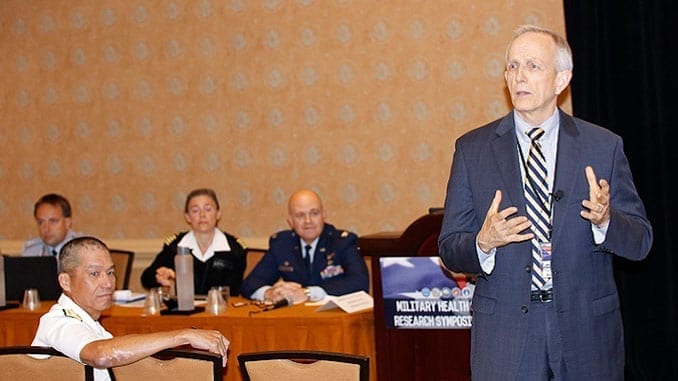
Global health engagement is an important security cooperation tool, building relationships and improving interoperability with partner nations around the world.
“Over the years, and in particular over the last few decades, we and our leadership have seen the connection between global health and global security,” said Dr. David Smith, deputy assistant secretary of Defense for Health Readiness Policy and Oversight. “Think of the destabilizing effects of threats like the HIV-AIDS epidemic, SARS, MERS-CoV, Ebola and Zika—this is going to be a continuing story for us.”
Smith was part of the group of senior leaders and experts from across the Military Health System (MHS) who came together to discuss the topic during a session at the annual MHS Research Symposium on Aug. 16.
Smith explained that the Department of Defense has taken a multi-faceted approach to address this reality, laying out four major focus areas that shape global health engagement:
- Force health protection, including efforts to protect service members from global threats like infectious disease or antibiotic-resistant bacteria through the constant monitoring of disease threats and the development of preventive measures, diagnostics, drugs and vaccines.
- Building capacity and interoperability with partner nations, including through bilateral and multilateral exercises in battlefield and disaster medicine.
- Humanitarian assistance and disaster response to lessen the destabilizing effects of disasters and public health crises.
- Cooperative threat reduction with partners, centered on enhancing global biosafety, biosecurity, and biosurveillance.
Navy Rear Adm. Colin Chinn, director of Research, Development and Acquisition at the Defense Health Agency and former command surgeon for the United States Pacific Command, reinforced these ideas while offering an operational perspective.
“Is global health engagement important for the combatant commanders? I can tell you the answer is absolutely yes—it’s very important for them,” said Chinn.
He cited examples from his experience in the Pacific region where engaging on global health issues has helped to establish or strengthen relationships in unique ways, including cooperation with China and Myanmar on a variety of military health issues, and with nations in the Mekong River region to fight the spread of malaria. He also praised the work researchers across MHS have done to advance the military’s role in global health.
“Our overseas medical laboratories are extraordinarily well-positioned to support important research on emerging public health threats,” said Chinn. “And the strategic international partnerships we’ve formed to study issues like infectious disease are essential as well. We need to continue these trends.”
MHS must continually assess the global landscape and the need for resources devoted to other global health concerns, argued Air Force Col. Alan Chambers, commander of the 779th Surgical Operations Squadron at Joint Base Andrews and former director of the U.S. Air Force’s International Health Specialist program.
“The World Health Organization estimates that more than 5 million deaths a year are attributable to injuries. Ninety percent of motor vehicle fatalities occur in developing countries,” said Chambers. “Trauma care is becoming more important for these countries.”
These statistics point to a need to invest in further capacity-building in treating and caring for trauma with partner nations, Chambers said. “We have great joint organizations like the Defense Institute for Medical Operations that have sent mobile training teams across the globe every year offering courses like Disaster and Trauma Resiliency, Trauma Surgical Techniques, and Aeromedical Evacuation. But we need to double down on these kinds of commitments and expand them.”
Smith further emphasized that developing a solid base of evidence through high quality research is a priority for DoD, in order to optimize its continuing global health engagement efforts.
The session featured a number of panelists both from within the MHS and from partner nation militaries. Navy Capt. Glen Diehl, director of the Center for Global Health Engagement at the Uniformed Services University of the Health Sciences and the session’s moderator, summed up the importance of the discussion.
“We’re here to bring together all the different interdisciplinary areas that are a part of global health engagement, determine what our requirements and capability gaps are, and most importantly, to drive toward new solutions,” said Diehl.
Source: Military Health System Communications Office, adapted.

